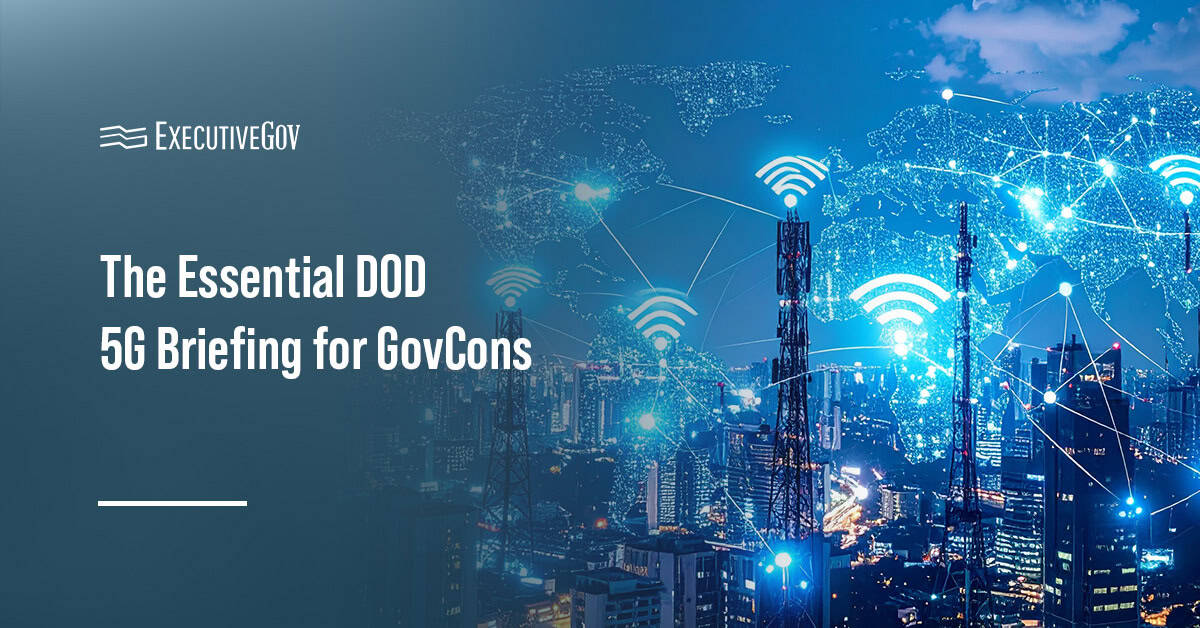5G technology represents a transformative leap in connectivity that GovCons cannot afford to miss. As the backbone of next-generation communications, 5G offers ultra-fast speeds, low latency and the capacity to support massive data flows, capabilities essential for defense, intelligence, homeland security missions and more.
From cybersecurity resilience to edge computing, 5G will shape how technology executives design and deliver government services. Let’s dive into the five most essential 5G updates to keep technology executives at the forefront of this revolutionary technology.
Get the latest military 5G business opportunities straight from Thomas Rondeau, the Pentagon’s principal director for FutureG and 5G, during his keynote at the Potomac Officers Club’s 2026 Defense R&D Summit on Jan. 29! Be the first to learn what the Defense Department needs from industry to accelerate 5G research and fielding. Get your pressing questions answered during Rondeau’s Q&A session. Sign up today for this elite GovCon event!
Table of Contents
1. DOD’s Path to 5G
DOD sees how 5G is improving how soldiers use weapon systems and communicate with each other. It has now embarked on an ambitious plan to install private 5G networks on military installations.
DOD in late 2024 issued its Private 5G Deployment Strategy, which is a framework for how the department seeks to best harness the power of 5G. DOD has three key objectives as part of this strategy:
- Prioritize mission, security, operating environment, performance and acquisition feasibility. DOD should perform a technical and business case analysis to analyze whether specific mission, coverage, security and performance requirements can only be met by private 5G.
- Accelerate acquisition, development and secure deployment of 5G. The department should increase the use of common architectures, risk frameworks and standards while adhering to cyber and supply chain risk management requirements.
- Expand the use of an Open Radio Access Network ecosystem. Open RAN offers transparent interfaces, component modularity and a new radio layer application capability. This will enable better vendor diversity, supply chain security and operational innovation.
By adhering to these three objectives, DOD believes it will use the most appropriate commercial wireless investments, standardize modernization processes, avoid stove-piped offerings and strengthen the defense industrial base, among other benefits.
2. A Real-World 5G Demonstration
DOD knows a demonstration is the fastest way to prove out 5G technologies and evaluate whether they are ready for battlefield action. The department recently awarded contracts to five teams for its Advanced Spectrum Coexistence demonstration that it expects to begin in November, DefenseScoop reported.
Previously called Advanced Dynamic Spectrum Sharing Demonstration, this program has a goal of validating emerging capabilities that would permit DOD and industry to simultaneously operate on the same electromagnetic spectrum band. Teams will evaluate cutting-edge spectrum-sharing technologies and use the output to educate the department’s upcoming work with the private sector on 5G.
Each of the military services use spectrum, specifically the 3.2-3.45 GHz S-band, as the basis for critical equipment such as weapons, radars and other systems. But the telecommunications industry has been asking for parts of that spectrum to be auctioned so it can be used for civil and commercial 5G uses.
5G capability will be critical for a DOD program that is a favorite of the White House: the proposed Golden Dome homeland missile defense system. Mari Silbey, National Spectrum Consortium chief program officer, said Golden Dome will require connectivity for alert, detection and counter-action. The bands that DOD covets for Golden Dome are highly desired both by the federal government and by industry.
The five teams that received contracts are: Peraton Labs, Interdigital Communications, Nokia Federal Solutions, RTX BBN Technologies and Northwestern University.
Are you a technology executive with a wireless communications portfolio? Then you can’t afford to miss a keynote address by Thomas Rondeau, principal director for FutureG and 5G in DOD’s OUSD for R&E, at the Potomac Officers Club’s 2026 Defense R&D Summit on Jan. 29! Learn directly from Rondeau how to tailor your offerings for contracting success. Spark collaborations with other GovCon titans and score that big contract. Secure your seat today!
3. Initial Contract Awards
Future Technologies announced on Sept. 16 that it was awarded over $50 million in contracts from DOD for efforts related to private 5G. As part of these awards, the department will improve operational continuity and provide services such as connected warfighter, augmented reality and virtual reality training, unmanned aircraft, AI-driven capabilities and test and training efforts, according to a company statement.
The company is broadening its connectivity services to support rising areas of interest to include research and engineering, research and development, advanced use case development, and more. Future Technologies is a lead system integrator with specialties in connectivity transformation, including requirement definition, procurement, design, deployment and sustainment of private networks.
4. Marine Corps Advances in 5G
The Marine Corps has been the DOD service leading the way in 5G experimentation. The corps in 2024 demonstrated an active radar and a 5G network in the same band without interference, a major milestone, according to USNI News.
A squad operating an AN/TPS-80 Ground/Air Task Oriented Radar, or G/ATOR, sent contract track through encryptors to a 5G device connected to a cellular network to enable air defense. Satellite nodes and radar contribute secure air defense and surveillance in maritime combat, but these aren’t reliable for DOD in the Indo-Pacific because of gaps in satellite coverage and high-tech threats from capable adversaries.
A three-year, DOD-sponsored 5G demonstration focusing on USMC units in the Expeditionary Advanced Base Operations—a.k.a. EABO—environment completed at the end of 2024. In a field demo spanning 48 hours, teams experimented with 5G technologies for different tasks and a variety of EABO missions, such as forward aircraft arming and refueling, perimeter security and long-range precision fires.
One of the DOD’s goals with these demonstrations is to expand the defense industrial base providing rugged, jam-resistant 5G communications. Few U.S. cellular firms are in that market and none of them have existing 5G networks capable, and secure, enough for DOD, said Scot Hoesly, Marine Corps Tactical Systems Support Activity program manager for the experiment.
5. 5G Opportunities for Industry
DOD’s experimentation with 5G has plenty of opportunities for GovCons. These include:
- Infrastructure development. DOD is looking for companies that can design and deploy Open RAN-capable private networks that prioritize flexibility and scalability.
- Security. The department seeks contractors developing advanced security protocols to meet the demanding needs of military users.
Data transfer and analysis capabilities. The Pentagon is prioritizing tools that allow secure data flow in Combined Joint All-Domain Command and Control infrastructure, bolstering decision-making velocity and accuracy.






